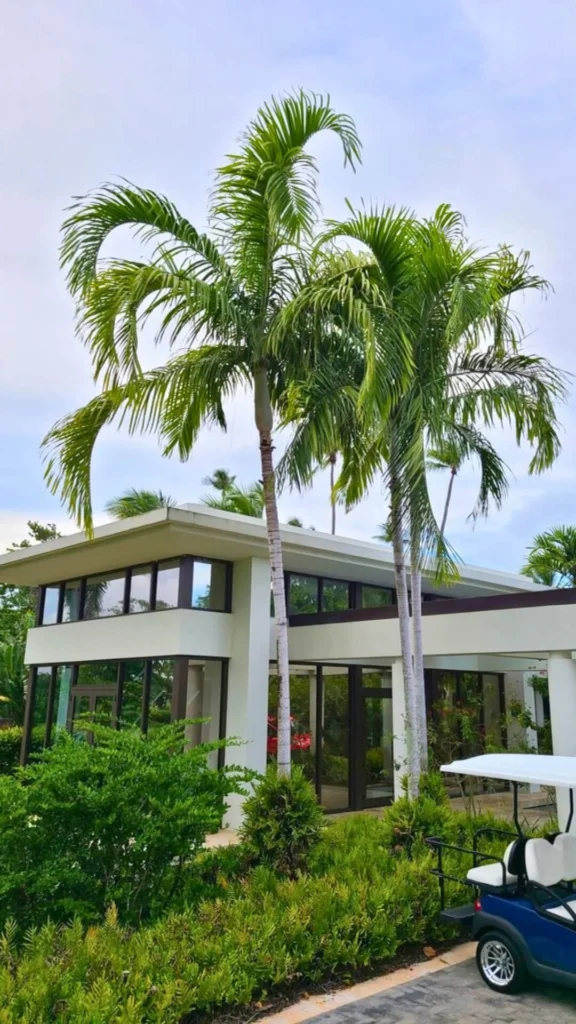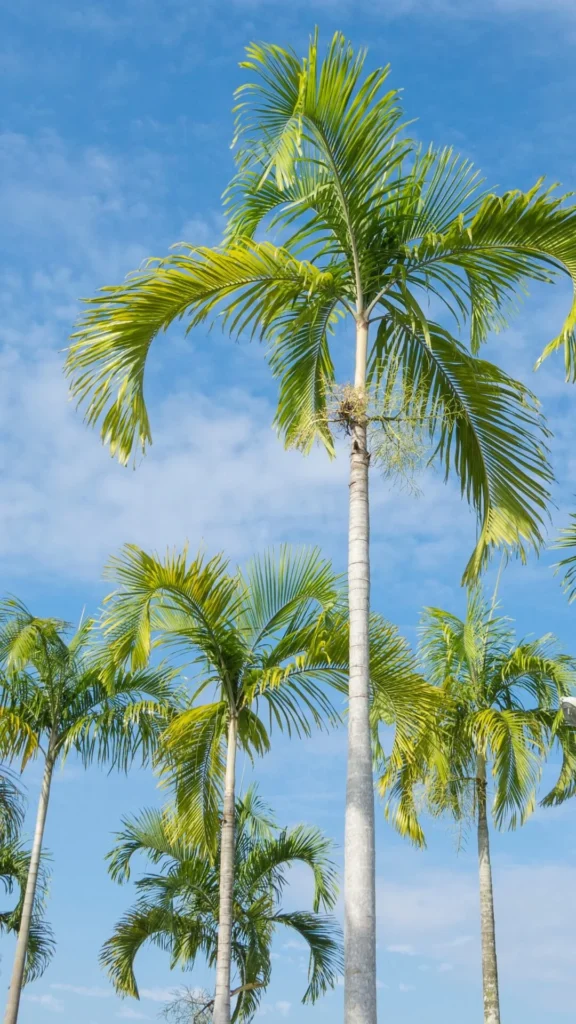
Carpentaria (Carpentaria acuminata), is one of the most remarkable and stunning palm species found in the tropical regions of northern Australia. It is native to tropical Australia, specifically the coastal regions in the northern Territory. It thrives in a wide range of environments, from rainforests to vine forests and swampy areas. Its presence can be observed from sea level to altitudes of 200 meters (656 feet).
After Cyclone Tracy in 1974, the city of Darwin, the capital of the Northern Territory of Australia, saw the growth of thousands of Carpentaria acuminata seedlings in the city’s gardens. The combination of strong winds and the exact timing of fruit ripening resulted in the species spreading, making it invasive and creating a significant management challenge with so many palms to control and the subsequent wildlife it attracted.
The genus name, “Carpentaria,” refers to the Gulf of Carpentaria, near its place of origin, while the specific epithet, “acuminata“, alludes to the shape of the fruits, which, although globular, have a small pointed tip. This majestic palm is highly valued for its beauty, rapid growth, and resilience to a variety of environmental conditions.

Photo by Steve Maldonado Silvestrini[/caption]
Carpentaria acuminata is the only species in the Carpentaria genus. It reaches an impressive height, potentially up to 20 meters (65.6 feet). Its solitary trunk is slender, with a diameter of about 12-15 centimeters (4.7-5.9 inches) and a color that ranges from gray to light brown, displaying spaced rings marking the location of fallen leaves. Carpentaria’s pinnate leaves can reach up to 4 meters (13.1 feet) in length and are arranged vertically along the trunk as they grow. The leaves have a dark green upper side and a bluish-green underside, making them visually stunning.
The base of the leaves is intensely green and wraps around the trunk for up to 1.3 meters (4.3 feet) in height. The inflorescences of Carpentaria acuminata emerge under the leaves and hang gracefully with cream-white flowers. The fruits are small, with a diameter of up to 20 mm (0.8 inches), globular in shape, and scarlet when ripe. It is important to note that the flesh of these fruits contains calcium oxalate crystals, which can be irritating to the skin and mucous membranes. Therefore, they should be handled with care, preferably using gloves. Nevertheless, they are quite attractive to fruit bats, doves, and other birds.
The Carpentaria Palm is often chosen for gardens in tropical and subtropical climates. Its majestic height and elegant leaves make it a focal point in many settings. It can be planted as a solitary tree or in groups and rows to create a striking focal area. Carpentaria is used to add a tropical atmosphere. Its imposing presence creates pleasant shade and a cozy environment, inviting people to relax and enjoy the surroundings. Due to its impressive height, this palm is often planted in front of buildings, monuments, and large architectural structures.

It acts as a symbol of grandeur and elegance, complementing the aesthetics of these places. The outdoor gardens of shopping centers and commercial establishments can also feature Carpentaria to create an inviting and stylish atmosphere. When planted along avenues and boulevards, this palm provides a uniform and imposing appearance. Its self-cleaning habit of shedding dry leaves makes it especially suitable for these locations. In tropical hotels and resorts, it contributes to creating a luxurious and exotic atmosphere. Its imposing stature and lush foliage provide a sense of escapism for guests.
Carpentaria not only impresses in gardens but also offers possibilities in decoration. Young plants can be used to decorate interiors, especially in spacious and well-lit spaces. It adds a relaxing tropical beach feel to the environment, creating an oasis indoors. When grown in a large pot, its long and elegant leaves become a focal point. It can also be used to decorate offices and corporate environments. In private residences, this palm is often used in living rooms and reception areas. Its tropical touch transforms these spaces into welcoming places to relax and entertain clients and guests. Carpentaria acuminata is known for its rapid growth, relatively easy cultivation, and low maintenance, provided its needs are properly met.

This palm thrives in full sun. However, during the first 2-3 years, it is advisable to keep it in a partially shaded position to protect the seedlings. It is not very demanding in terms of soil type and will grow well in well-drained soils, as long as they are regularly irrigated, especially during dry periods. During the first year after planting, it is crucial to keep the palm well-watered. Adding organic matter to the soil is beneficial for the palm’s healthy development. It is adaptable to a variety of climates but prefers subtropical and tropical climates. It is not very tolerant of coastal salinity.
When young, it is sensitive to cold, but over time, it becomes more resistant to lower temperatures. In warm or subtropical temperate climates, it can be grown in favorable microclimatic niches, tolerating temperatures occasionally close to 0°C (32°F), but only for short periods. The Carpentaria Palm is known for its resistance to moderate urban pollution and is generally resistant to most diseases.
The reproduction of Carpentaria acuminata is done from seeds. It is important to ensure that the seeds are fresh, as their germination is limited over time. The ideal temperature for germination ranges from 26-28°C (79-82°F). After sowing in a moist substrate, germination should occur within 1 to 3 months.

